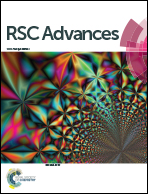Degradation of polycyclic aromatic hydrocarbons (PAHs) in textile dyeing sludge by O3/H2O2 treatment
Abstract
The degradation of polycyclic aromatic hydrocarbons (PAHs) in textile dyeing sludge by O3/H2O2 treatment was investigated. Fluorene (Fl), phenanthrene (Ph), anthracene (An) and dibenz[a,h]anthracene (DBA) were selected to represent typical PAHs. The effect of radical inhibitors, H2O2, O3 flow rate, pH and reaction time on the degradation of the four types of PAHs were examined to determine the optimal conditions for degradation and to clarify the mechanism(s) of PAHs degradation. The results indicated that the combined O3/H2O2 treatment resulted in high removal rates of the selected PAHs: 89% for Fl, 66% for Ph, 71% for An and 81% for DBA. These results correspond to the optimal conditions of an O3 flow rate of 0.4 L min−1, a H2O2 concentration of 0.60 mol L−1, a reaction time of 15 min and pH 7. The removal rate (within 30 min) increased by 5% for Fl, 27% for Ph, 21% for An and 5% for DBA through the addition of H2O2 to the O3 process. The O3 flow rate, reaction time and pH were the key parameters affecting PAH degradation with multiple interacting factors (p < 0.05) by the O3/H2O2 treatment. The degradation of the PAHs can be fitted well by pseudo-first-order kinetics (R2 = 0.9656). The combined O3/H2O2 treatment is demonstrated to be an efficient approach for the degradation of PAHs in textile dyeing sludge.


 Please wait while we load your content...
Please wait while we load your content...